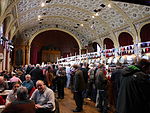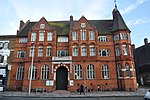Battersea Town Hall
1891 architecture1893 establishments in EnglandAC with 0 elementsBuildings and structures completed in 1893Buildings and structures in Battersea ... and 3 more
City and town halls in LondonGrade II* listed buildings in the London Borough of WandsworthUse British English from April 2022

Battersea Town Hall, originally the New Parochial Offices, Battersea, is a Grade II* listed municipal building in Battersea, south London, designed by Edward Mountford and erected between 1891 and 1893 by the Battersea vestry to provide public halls and office space for its staff. The building served for 72 years as the hub of municipal Battersea until the centre of local government was moved to neighbouring Wandsworth in 1965, after which it transitioned to use as a community and arts centre, latterly known as the Battersea Arts Centre.
Excerpt from the Wikipedia article Battersea Town Hall (License: CC BY-SA 3.0, Authors, Images).Battersea Town Hall
Theatre Street, London Clapham Junction (London Borough of Wandsworth)
Geographical coordinates (GPS) Address Nearby Places Show on map
Geographical coordinates (GPS)
| Latitude | Longitude |
|---|---|
| N 51.46513 ° | E -0.16076 ° |
Address
Battersea Arts Centre
Theatre Street
SW11 5NF London, Clapham Junction (London Borough of Wandsworth)
England, United Kingdom
Open on Google Maps











